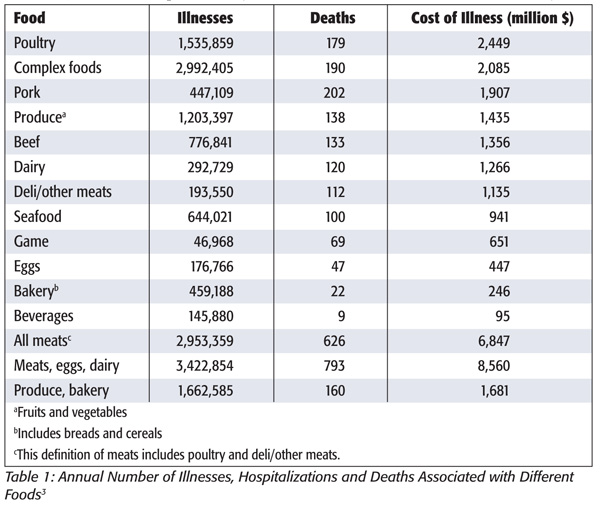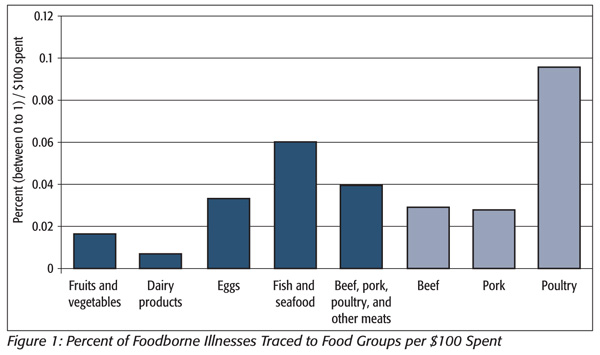PART 1: Which is more dangerous to consume: Plant or animal
There is an ongoing debate about the “organic” or “country-reared” animals. This series of articles looks at research conducted on consumer perceptions and how this correlates to food safety. We'd love to hear your opinion.
Animal welfare vs food safety
The 2011 movie Contagion tells a fictional story of how globalization and ease of travel can produce fast-spreading pandemics, killing people more quickly than government authorities can respond. The culprit for this Hollywood illness is a new virus of unknown origin, resistant to all known vaccines.
It isn’t until the end of the movie that the origin of the killer is revealed. It all began (spoiler alert) with a bat carrying a piece of banana to a hog farm. The bat manages to fly into an enclosed building where sad-looking hogs are housed in tight quarters. The bat drops the banana on the floor, where it is quickly eaten by a hog. Presumably, the banana or the bat carried a virus, which spread to the pigs. One of the pigs is then slaughtered, and a man carving the meat in China fails to wash his hands before he shakes the hand of a character played by Gwyneth Paltrow, who then travels back to the United States where she dies—but not before sickening many others.[1]
The premise of Contagion is that raising hogs on “factory farms” encourages the emergence of deadly pathogens. How accurate is this caricature? In reality, a bat is more likely to drop food near hogs or chickens raised outdoors. Would the movie have been more realistic if the bat infected a pig raised on an organic farm, a farm where animals roamed “free range,” or a farm owned by a small producer slaughtering his own animals and selling locally? Or would a more accurate film show the bat shedding feces near a field of broccoli, sickening people consuming fruits and vegetables instead of meat? Is it true that animal welfare and food safety are trade-offs, or are they instead complements? When we pay more for humane meat, are we also getting safer food or are we accepting greater risk? These are the questions we investigate in the present article.
Animals versus plants
Before discussing the relationship between animal welfare and food safety, it is useful to step back and look at the big picture. If asked, many people would probably consider foods derived from animals to be less safe than those derived from plants. Yet, news stories routinely report outbreaks from jalapeños, melons, tomatoes and lettuce. If a vegan is just as likely to suffer from a foodborne illness as a meat eater, then the discussion of animal welfare and food safety takes a different tone.
Which is more dangerous to consume: plant or animal? One recent survey of food safety experts suggests a belief that eating produce is riskier than eating pork, beef, eggs, poultry or dairy.[2] Part of this assessment, however, is due to aggregation. All fruits and vegetables are grouped into one category; different types of meats are counted separately.

More insight can be gained by investigating actual outbreak data. Table 1 reports the results of an analysis utilizing 10 years of U.S. Centers for Disease Control and Prevention outbreak data (from 1999 to 2008) to calculate the number of annual illnesses and deaths attributable to different foods as well as the economic costs of the illnesses (medical costs, productivity losses and estimates of the value of mortality).[3] Even if poultry alone is compared with all produce, poultry results in more illnesses and deaths. Beef causes more illnesses but fewer deaths than pork, and eggs appear safer than any of the meats. Vegan advocates claiming that animal-derived foods are riskier to consume4 apparently have some evidence to support them. Fewer illnesses or deaths result from the consumption of bakery and produce than meats, eggs and dairy. Moreover, many of the illnesses from produce originate from livestock and spread to plants through the wind or poor manure treatment.[5] The Center for Science in the Public Interest calculates that roughly one-third of all foodborne illnesses from a plant source is of animal origin, whether it be livestock or wildlife.[4, 6]
Investigating the sources of foodborne illnesses also helps us understand the link between animal welfare and food safety. If the most humanely produced foods are also the safest, perhaps this correlation suggests causation? The comparisons in Table 1 are in some ways unfair, though. Americans today consume more poultry than any other meat product,[7] so even if a meal containing poultry is safer than beef or pork, more illnesses may result from poultry consumption simply because chicken is consumed on such a large scale. Using the data in Table 1 to claim poultry is risky is a bit like claiming roads in Texas are more dangerous than those in Wyoming simply because more Texans die in car crashes—however, the population size of the two states would seem the more logical culprit. Analogously, the volume and value of the food should be taken into consideration when comparing risks. Consumers might voluntarily accept riskier food if they value it more.

For a better comparison, we took the illness values in Table 1, converted them into percentages and divided the percentages by the amount of money a typical household spends on each food type.[8] What results is an index of food risk accounting for both consumption and value of the foods. As shown in Figure 1, meats remain more than two times riskier than produce. The risks associated with eggs relative to other foods, however, are greatly increased compared with Table 1. Eggs may not cause more illnesses than produce overall, but for each dollar spent, they do. The risk from seafood also rises, and though produce may cause more illnesses than beef overall, each dollar spent on beef is more likely to get you sick than a dollar spent on produce. As in Table 1, poultry remains the riskiest food to consume.
What does Figure 1 tell us about the relationship between animal welfare and food safety? The actions of animal advocacy organizations suggest that they believe animal suffering to be especially profound on egg and pork farms, and for welfare to be relatively higher on beef and dairy farms. Clearly, food safety is not determined solely by animal welfare, as beef is less risky than eggs but about the same as pork. Poultry is much riskier than pork or eggs, yet we believe welfare to be considerably higher for broilers than hogs or layers. It is clear from Figure 1 that food safety must be influenced by many other factors in addition to animal welfare.
Still, there are many reasons to believe a welfare-safety link exists. This means that when we debate how animals should be treated, we are also debating the safety of our food. In the next section, we explore the ways in which animal well-being can be improved and the concomitant change in food safety we should expect.
References
1. Shamberg, S.S. and G. Jacobs [producers]. Soderbergh, S. [director]. Burns, S.Z. [writer] 2011. Contagion [film]. Warner Brothers Pictures [distributor].
2. Hoffman, S. 2009. Knowing which foods are making us sick. Choices 2nd Quarter. 24(2).
3. Batz, M.B., S. Hoffmann and J.G. Morris Jr. 2012. Ranking the disease burden of 14 pathogens in food sources in the United States using attribution data from outbreak investigations and expert elicitation. J Food Prot 75(7):1278–1291.
4. Jacobson, M.F. and Staff of the Center for Science in the Public Interest (CSPI). 2006. Six arguments for a greener diet. Center for Science in the Public Interest.
5. Matthews, K.R. 2009. The produce contamination problem: Causes and solutions, eds. G.M. Sapers, E.B. Solomon and K.R. Matthews. Burlington, MA: Elsevier Inc.
6. We contacted the CSPI to discuss this calculation and believe their assumption of one-third is reasonable.
7. Norwood, F.B. and J.L. Lusk. 2011. Compassion, by the Pound. New York: Oxford Press.
8. Expenditures on beef, pork, poultry and other meats (as a single group) are $842 per year. The numbers for dairy, fruits and vegetables, eggs, and fish and seafood are $481, $842, $60 and $120, respectively. Numbers for beef, pork and poultry are $300, $180 and $180, respectively. These numbers are taken fromwww.bls.gov/cex/home.htm#publications.
Article reproduced with permission from Food Safety Magazine
Source: Food Safety Magazine
F. Bailey Norwood, Ph.D., and Jayson L. Lusk, Ph.D.





